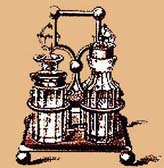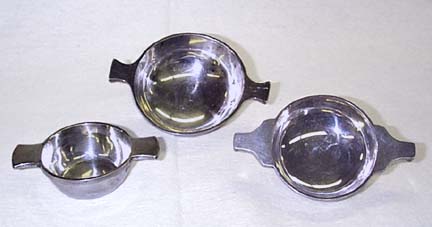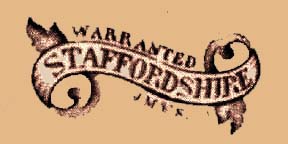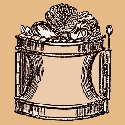

 VICTORIAN
SILVERSMITHING
VICTORIAN
SILVERSMITHING
![]()
 |
Sterling Wine Testing Cups or "Quaichs" (Scottish type
of vessels). Center: hallmark at rim "E&C," Elkington & Company, Ltd., Birmingham, England. Date: 1909-1910. CAS 0389-1953 Right: hallmark "Willson & Sharp Ltd.," Edinburgh, Scotland. Date: 1799-1800. CAS 0389-2015 |
![]()
|
|
Silverplate Pepper Mill (left). Nickel silver. CAS 0389-1950 Saltshaker (center). Electroplating on nickel silver. CAS 0389-1276 Sheffield Plate Tea Ball (right). Hallmark "A,B,J,B," London, England. Date: 1858-1859. CAS 0389-1663 |
![]()
|
Dinner Cruet or Condiment Holder Set (left). Electroplating on nickel silver, bottles in pressed and cut glass. CAS 0389-1051A-H Pickle Canister with Lid, Serving Stand and Tongs (right). Triplated and pressed glass. Hallmark: "ROGERS & BRO." The upper panel lid is made in typical Victorian mythology design. CAS 0389-1359A-D |
![]()
|
|
Bottle Stand (left). Base wood, silverplate and pewter (or Britannia metal). CAS 0389-1283 Silverplate Cup Stand or Glass Stand (center). CAS 0389-1279 Wine Bottle Chiller or Soda-Syphon Stand (right). Electroplate on nickel silver. Hallmark: "WS & S." CAS 0389-1285 |
 BIBLIOGRAPHY
BIBLIOGRAPHY
| BURY, SHIRLEY Victorian Electroplate. London, Country Life Collector's Guides. 1971 |
| FALES, MARTHA GANDY Early American Silver. New York, Funk & Wagnalls. 1970 |
| WYLER, SEYMOUR B. The Book of Sheffield Plate. New York, Crown Publishers. 1949 |
 |
 |
 |
 |
|
| Kitchen Technology | Silversmithing | Blue & White Crockery | Food Molds | Victorian Kitchens Home |